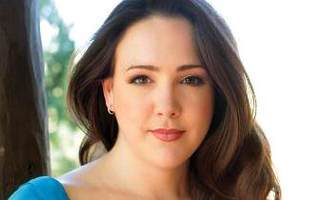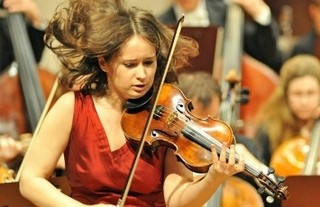|
Back
The Vivace and The Dead New York
Avery Fisher Hall, Lincoln Center
08/22/2014 - & August 23, 2014
Johann Sebastian Bach: Chorales from St. John Passion, BWV 245
Frank Martin: Polyptyque
Wolfgang Amadeus Mozart/Franz Xaver Süssmayer: Requiem, K. 626
Patricia Kopatchinskaja (Violin), Susanna Phillips (Soprano), Kelley O’Connor (Mezzo-soprano), Dmitri Pittas (Tenor), Morris Robinson (Bass)
Concert Chorale of New York, James Bagwell (Director), Mostly Mozart Festival Orchestra, Louis Langrée (Conductor)

S. Phillips (© Mostly Mozart Festival)
If the full house Mostly Mozart audiences came to hear one solemn religious work and one theatrical work for chorus and orchestra, they had the genres right. Except that Mozart’s Requiem was the flashy theater piece and the “other music” was more religious, more solemn and more mystical than anything Mozart could have imagine.
The legend that Mozart was composing his Requiem for his own funeral makes a great poem for Pushkin, a terrific opera for Rinsky-Korsakov and a good movie in Amadeus, but nobody has yet found a corpse in a single section of this short Mozart opus.
Short indeed, since little of it is finished, and the rest was a forgery by Franz Xaver Süssmayer, who not only had Mozart’s confidences, but whose handwriting was similar to the composer’s. Thus Mozart’s wife could collect her commission.
If this sound irreligious, whatever we have left of the Requiem is more triumphant, more like a Handelian paean than funereal pain. And evidently, conductor Louis Langrée felt the same way. Not the slightest nuance was felt that this was a High Requiem Mass. The chorus sometimes yelled (as in the Dies Irae, at other times, the voices were jumbled together. In fact, after the Bach chorales of the first half, the Concert Chorale of New York was like a different choir.
Perhaps they were stymied by the crazily forward tempos. Or perhaps Mr. Langrée took the Elizabethan translation “the quick and the dead” to mean, “the vivace and the dead.” (I had to look up the original “quick” defined as an archaic way to say “living”).
His soloists were in good voice, and their Benedictus, actually written entirely by Sûssmayer, so he didn’t have to fool around with Mozart’s sketches, was sung beautifully. I cannot fault either of the men, especially the commanding Morris Robinson. Nor did the work by Susanna Phillips and Kelley O’Connor sound individually or in ensemble anything but gorgeous.
Yet in the ensembles and choruses, I felt that this was not Mozart, but outtakes from middle-period Verdi, a Trovatore sung in Latin.
Still, this concert, the final Mostly Mozart event, was more than religious. It was mystically religious from a work new to this writer and to most in the audience.
Frank Martin’s concerto, commissioned by the always-mystical Yehudi Menuhin, was based on six paintings from Sienna, probably in the gorgeous cathedral with its walls covered with art and ancient music. The paintings were about the last hours of Jesus, and the Polyptyque (Six Images of the Passion of Christ) seemed to be made for the 37-year-old , intense Moldovan-Austrian, Patricia Kopatchinskaja.

P. Kopatchinskaja (© Courtesy of the Artist)
Standing in front of the two string orchestras, swaying at times, always concentrated, she played Frank Martin’s picture–the inner Last Supper, the ghoulish picture of Judas, and the fervent last glorious moments–with a vividness, a fierce belief. I dare not ask what her religion is, but in this work, she obviously believed in music what the images generated for the composer.
In between these movements, the Concert Chorale sung five movements from Bach’s St. Matthew Passion, again a quasi-mystical way to bring the story from century to century. The Mostly Mozart Festival Orchestra (and the soloist) accompanied them, but the chorus, in full voice, with perfect harmony, offered what was missing in the Mozart, a religiosity, a divinity and both a Biblical and musical revelation.
****
CODA: May I make a heretical suggestion? Instead of the constant arguments about which Requiem music was written by Mozart, music adapted and revised by others, why not bring back the one composer who can do things better?
Luciano Berio not only “finished” Turandot (to be performed next year by the Phil), but filled in Schubert, Boccherini, Purcell and others to perfection. I don’t think that Mozart can do it, but maybe some Tuba Mirums from Berlioz or Verdi, can summon Mr. Berio from the grave, and he could be given a commission to finally give us a requiem worthy of Mozart himself.
Harry Rolnick
|